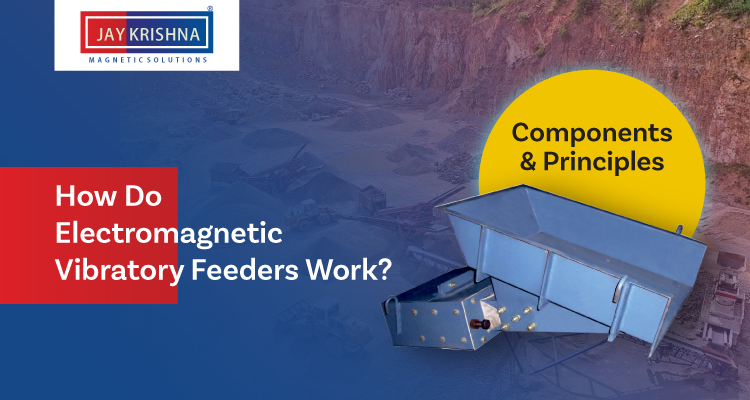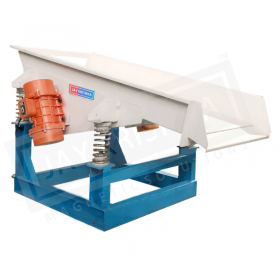How do Electromagnetic Vibratory Feeders Work? – Components & Principles

Electromagnetic Vibratory Feeders are machines that are commonly used in many different industries and manufacturing facilities like glass, cement, mineral processing, metal, chemical, foundries, ceramic, etc.
They can carry out different processes like screening, packaging, and conveying. The machine can be used to handle bulk materials as well. They are used to create a smooth and volumetric flow of products.
Electromagnetic Vibratory Feeders are manufactured to be efficient and are able to handle abrasive materials and high-temperature materials. They are also able to meet sanitation requirements as the feeder trays don’t accumulate material and Electromagnetic Vibratory Feeders have self-cleaning properties as well.
In this blog, to understand how an Electromagnetic Vibratory Feeder works, we have elaborated upon how it works and what parts it comprises of.
Working Principle
The machine’s name is self-explanatory. The Electromagnetic Vibratory Feeder works by making the feeder tray vibrate. That is how it carries out the conveying process.
Using a controlled vibratory force, vibratory feeders are used to move materials in bulk.
The product is put in the feeder tray. The product moves in a number of hops when the tray vibrates. The continuous motion of the product is created by a sequence of hops. The vibrations are created by a combination of horizontal and vertical actions. This series of actions are created by the magnet that is present under the feeder tray. The magnetic pulses created by the magnet is what generate the vibrations.
An alternating electric current moves through a coil under the feeder tray, this current attracts the magnet as it moves in one direction, this attraction causes the springs to become tense. When the current moves in another direction, the magnet is released which causes the spring to move the tray. When this entire process is repeated at a high frequency, the vibratory motion is generated.
The direction and movement of the material that is being processed are affected by the angle of the spring. The angle can be set to determine in what direction you want the material to slide and move.
Components
Now that we know how an Electromagnetic Vibratory Feeder works, let us get to know its different components. The machine is made up of the following parts and components:
Feeder Tray
The feeder tray is a trough-like/trough-shaped tray that is the part of the machine that is used to handle the products and materials. The feeder tray’s main role is to direct the product being fed to where it needs to go.
The tray is designed and made to make sure no product spills out while processing. The tray also needs to be made in a way that ensures that most of the energy produced by the machine is transmitted into the product, to make sure proper separation occurs. This process is made certain by designing the tray to be rigid.
Spring
A spring connects the feeder tray to the base unit of the machine. The springs are also the component that enables the feeder tray to oscillate and vibrate.
Because the magnet operates at a set frequency and the feeder tray also vibrates at its own natural frequency, the machine needs to be made to ensure that the combined frequency would be the same. This is determined by the stiffness of the springs and the mass of the tray.
Making sure that the machine vibrates at a similar frequency has the benefit of encouraging the flow of the product and decreasing the stress on the feeder tray.
Magnet and Coil
The coil is used to attract the magnet. The coil is attached to the base unit, while the magnet is attached to the feeder tray. The electric current passed through the coil attracts the magnet, this attracts the feeder tray too. The vibrations are caused by this electromagnet being attracted and repulsed quickly and continuously.
Base Unit
The base unit acts as the base for the entire machine. It is the lower mounting point of the springs, with the feeder being the upper point. Other than this, the base is used to make sure that the vibrations from the machine do not take over the entire machine and damage surrounding structures, machines, and infrastructure. The mass of the base prevents the vibrations from being transmitted out of the equipment.
The base moves in an equal and opposite way to the feeder. The mass of the base is inversely proportional to the movement of the base, so to reduce movement, the mass needs to be increased.
The base is also attached to the support structure by the rubber blocks.
Feeder Control Systems
The control requirements of a Vibratory Feeder are very few. The only controls are ‘stop’ and ‘start’, as once the machine is set up the feeder stay will function accordingly.
Feeder Control Applications
The Electromagnetic Vibratory Feeder is usually part of a production line, so the product flows from the feeder into another machine in the production line. This is why the machine also possesses sensors.
Some machines can only take a finite amount of product to process and so the sensors will tell the feeder when to stop discharging product onto the next machine and when to restart.
Variable Speed Control
An inverter can be used to adjust the frequencies of the feeder tray to change the speed of the product. Higher vibrations and hops will mean the product is processed faster. But this method of control has limited uses as the machine is set up to work at a specific set of frequencies and changing them using an inverter may reduce the effectiveness of the vibratory process.
Other Components
Some other components of the machine include:
- Feed End: this is the side of the machine that is used to feed the materials onto the tray.
- Discharge End: this is on the downstream side of the machine, opposite the feed end. It is the side from which the material is ejected off the tray. it can be connected to another machine in a production line as well.
Jaykrishna Magnetics Pvt. Ltd. is a leading manufacturer of magnetic, vibratory, electromagnetic and mineral processing equipment. Our equipment is made to be strong, durable and long-lasting, which applies to our Electromagnetic Vibratory Feeders as well.
To know more about our vibratory feeders and other products, please visit our website: www.jkmagnetic.com
- How do Electromagnetic Vibratory Feeders Work? – Components & Principles
- What Is PET Recycling & How Eddy Current Separator Plays An Important Role In Metal Separation
- Lithium-Ion Battery Shredded Scrap Separation By Eddy Current Separator – A Definitive Guide
- Magnetic Separators For Detecting Impurities In Food Processing
- Why Quality Magnetic Destoner Matters in Food Processing Lines?


